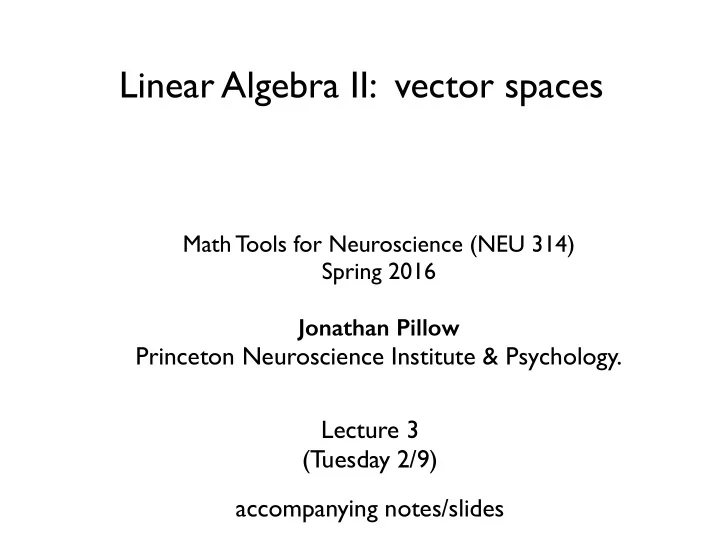

Linear Algebra II: vector spaces Math Tools for Neuroscience (NEU 314) Spring 2016 Jonathan Pillow Princeton Neuroscience Institute & Psychology. Lecture 3 (Tuesday 2/9) accompanying notes/slides
discussion items • Up now on piazza: • Chapter 2 of Wallisch et al (Matlab for Neuroscientistis) • homework 0 (Matlab basics). • This week in lab: do interactive lab (“lab 1” linked from website) and then work on homework 0.
today’s topics • linear projection • orthogonality • linear combination • linear independence / dependence • vector space • subspace • basis • orthonormal basis
linear projection • intuitively, dropping a vector down onto a linear surface at a right angle • if u is a unit vector, length of projection is v ^ u ^ ( . ) v u ^ u } component of v in direction of u • for non-unit vector, length of projection =
orthogonality • two vectors are orthogonal (or “perpendicular”) if their dot product is zero: v component of v orthogonal to u ^ u ^ ( . ) v u ^ u } component of v in direction of u • Can decompose any vector into its component along u and its residual (orthogonal) component.
linear combination • scaling and summing applied to a group of vectors v v 1 3 • a group of vectors is linearly v dependent if one can be written as 2 a linear combination of the others • otherwise, linearly independent
vector space • set of all points that can be obtained by linear combinations of some set of “basis” vectors v 2 v 2 v v 1 1 v 1 1D vector space Two di ff erent (orthonormal) spanned by single bases for the same 2D basis vector vector space
vector space • set of all points that can be obtained by linear combinations of some set of “basis” vectors v 2 v 2 v v 1 1 v 1 1D vector space Two di ff erent (orthonormal) ( subspace of R 2 ) bases for the same 2D vector space
basis • set of vectors that can “ span ” (form via linear combination) all points in a vector space v 2 v 2 v v 1 1 v 1 1D vector space Two di ff erent (orthonormal) ( subspace of R 2 ) bases for the same 2D vector space
orthonormal basis • basis composed of orthogonal unit vectors
Recommend
More recommend